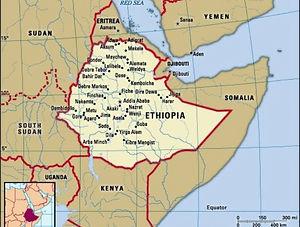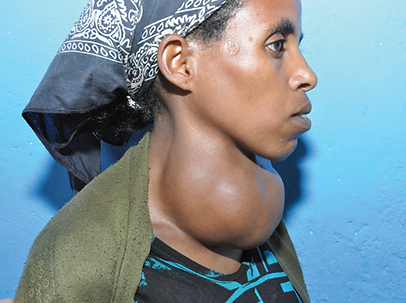

ETHIOPIA
ETHIOPIA: The Land of origins...

Fun fact: The star represents the unity of all Ethiopian nationalities, its rays the bright prospects for their future. Blue is for peace, yellow for hope, justice, and equality. Red represents sacrifice for freedom and equality, while green is equated with labour, development, and fertility
About Ethiopia
Location/ Size

Ethiopia is located in Africa
In the Horn of Africa
The Area of Ethiopia is 1,104,300 sq. Km
It is landlocked
Ethiopia is bounded by Eritrea to the North, Djibouti to the Northeast, Somalia to the East, Kenya to the South, and South Sudan and Sudan to the west
It is a place of ancient culture
Lake Tana is Ethiopia´s largest inland Lake and the main reservoir for the Blue Nile River

Population

Fun Facts
The Capital City of Ethiopia is called:
Addis Abeba
It means ´New Flower´
There are more than 80 different Ethnic
groups with just as many languages and over 200 dialects spoken throughout the country
The main language is called Amharic
Ethiopia is the only country in Africa with its own unique script
Ethiopia is the diplomatic capital of Africa
Coffee was discovered in Ethiopia, in the region of Kaffa
Teff, the grain used to make the Ethiopian staple injera.
- The current population of Ethiopia is 115, 567, 112
-The median age in Ethiopia is 19.5
-Life Expectancy is 67.81 years
-Infant mortality 29.5
-Death under age 5 is 44
Health Indicators
Ethiopia
39.12 per 1,000 people
2,660.75 (Ranked 11th)
56.19 years
77.12 deaths/1,000 live births
21.86 per 1,000 people
United States of America
14 per 1,000 people
5,124.49 (Ranked 4th)
78.37 years
6.06 deaths/1,000 live births
3.27 per 1,000 people
Common Communicable
Diseases
The top leading causes of inpatient deaths in most regions of Ethiopia are:
Pneumonia
Tuberculosis
Human Immunodeficiency Virus (HIV)
Malaria
There are 4 major non-communicable diseases in Ethiopia:
Cardiovascular disease
Diabetes
Cancer
Chronic Obstructive Pulmonary Disease
The World Health Organization (WHO) estimates that 34% of Ethiopian population is dying from these non-communicable diseases
Common
Non-communicable
Diseases
WHO strategic functions in reducing avoidable morbidity and mortality among vulnrable populations
-Health assessment, tracking and Advocacy
-Coordinated Emergency Health Action
-Identifying and Filling the Gaps in Disaster preparedness and Response
-Strengthen Local Capacities for Better Health Outcome
Health System
Ethiopia is a country with 85% of its population living in rural areas and more than 75% of the diseases that affect its populations are preventable (2018). Despite this, its health policy that focuses on curative and urban-centered health services, made its healthcare system ineffective. Another reason for the system's ineffectiveness is the scattered nature of the rural populations and the nomadic-pastoralist way of life of many others, that may have hindered the accessibility of healthcare services. Another obvious failure is the inadequately staffed health centers throughout the country and the lack of physicians available in the public sector
The country only recently launched a new health policy putting much more emphasis on prevention which is more appropriate to address most of the health problems of the population. This policy includes focusing on decentralization, expanding the public health system, and ensuring and encouraging the participation of the whole community in health activities (Gebreab,2020). The strategy employed to achieve this goal is the implementation of the Health Service Extension Program with the aim of bringing health services delivery to the family level in rural communities where such a big percentage of the total population.
Health and Education
The Literacy rate in Ethiopia, at 49.1%, is much lower than regional and world averages. It maintains two educational systems: the traditional system rooted in religion at the primary level and often conducted by clergy, and public education. Public education, while free and compulsory, is not satisfactory. Only less than 60 percent of children are enrolled in full-time education, while 32%of official primary school ages are out of school (Crummy, 2020). For a significant proportion of these, participation in household chores is associated with significantly less time in school as well as accounting for measurable deterioration in children's health status.
A country's education coverage and quality is directly linked to the provision of basic health care to the population throughout the county. The success of any health program designed to address the most common health hazards like sanitation, hygiene, nutrition, safe drinking water, gender and social concern, are considerably improved with increased literacy and education results in effective implementation of health programs, and ensures better current and future health outcomes. this is why the World Health Organizations promotes expansions in education not only to improve health but also a means to prevent important health risk (Gebreab, 2020).
Culture
In Ethiopia, health, or how most people’s view of illness is closely related to culture and/or religion. As I have mentioned in my ‘Health system’ and ‘Health Education’ posts, Ethiopia is a country with 85% of its population living in rural areas and the literacy rate is at 49.1%. therefore, most people believe that illnesses are caused by supernatural forces; an individual or a family’s health and safety depends on the individual or family member’s involvement and interaction with the supernatural powers. Naturally, when these people get sick, they tend to go religious leaders to get rid of the unclean spirit, that is causing the illness. However, the younger and more educated generation tend to believe that the causes of diseases are mostly ‘germs’ and ‘bacteria’.
I am originally from Ethiopia. I came to the United States when I was 16 years old. Thirteen years later, I went back to visit. Even though I grew up here and now have lived more than half of my life here, I find that I am very much influenced by the Ethiopian culture. Ethiopia is a male dominant country. men are the breadwinners and women stay home and raise their children. There were few exceptions (back when I used to live in Ethiopia), of which my mother was one. She was a businesswoman. She owned her own grocery store and restaurants at one point. However, even if a woman works and makes a good living, she is regarded as inferior to men. It was almost like women are seen as properties under the ownership of the man. Fortunately, things are changing now, with the new Prime Minister. He understands the value of women and he intentionally involves women in politics and even elected the first Woman President, which is outstanding.
2 Common cultural practices:
Family structure: Ethiopia is a family-oriented culture. It is common for grandparents to live with the family when they get older and cannot take care of themselves. It is not uncommon for extended families to live together. I believe this is a helpful in every aspect of life. Having close bonds and relationships that are supportive can only be beneficial to your physical and mental health.
Early marriage: Predominantly in rural Ethiopia, early marriage is a common practice. In Northern Ethiopia, girls as young as seven are married to teenage boys or older men (Segobye, 2016). It just breaks my heart to know that this is something that is still happening in my home country. These girls are physically, mentally, emotionally not ready for any of this. Once these girls are old enough to have children, they quickly become pregnant. They usually do not get the proper medical assistance, which is one of the reasons why Fistulas are common in places where early marriages exist.
Environmental factors/
Health promotion
Factors: Communicable diseases are considered as major causes of morbidity and mortality as well as disability in Ethiopia. The high prevalence of communicable diseases in the country is linked to the poorly developed socio-economic and environmental factors that have been inherent for centuries. (Berhane, Kumie, & Samet, 2016) Ethiopia is, with its long history of health services development, still waging struggles for the control and prevention of communicable diseases that are mainly transmitted because of poor living environmental conditions.
Health Promotion: The most obvious conclusion one can make it so work on the maintenance of environemntal health. There, is a need to popularize, reinforce and sustain a modes approach to encourage demand driven, community involvment and hygiene education in order to bring rapid improvement in water and sanitation services (Berhane, et al, 2016).

Nutritional factors/
Health promotion
Factors: According to Nutrition Country Profiles, high incidence of infectious disease and nutritional deficiencies, low immunization coverage and low access to improved water sources and sanitation are the major factors contributing to high morbidity. The dietary energy supply is not sufficient to meet population energy requirements and almost half of the population is undernourished. Besides being quantitatively insufficient, food supplies also lack diversity. Iodine deficiency disorder are still highly prevalent.
Health Promotion: In order to have a positive impact on economic growth and development of the country, major efforts are needed to rapidly and sustainably improve the health and nutritionals status of the population. For example, Iodized oil capsules should be implemented urgently (Nutrition country profiles: Ethiopia Summary, 2020). As well as education about adding diversity in food.
